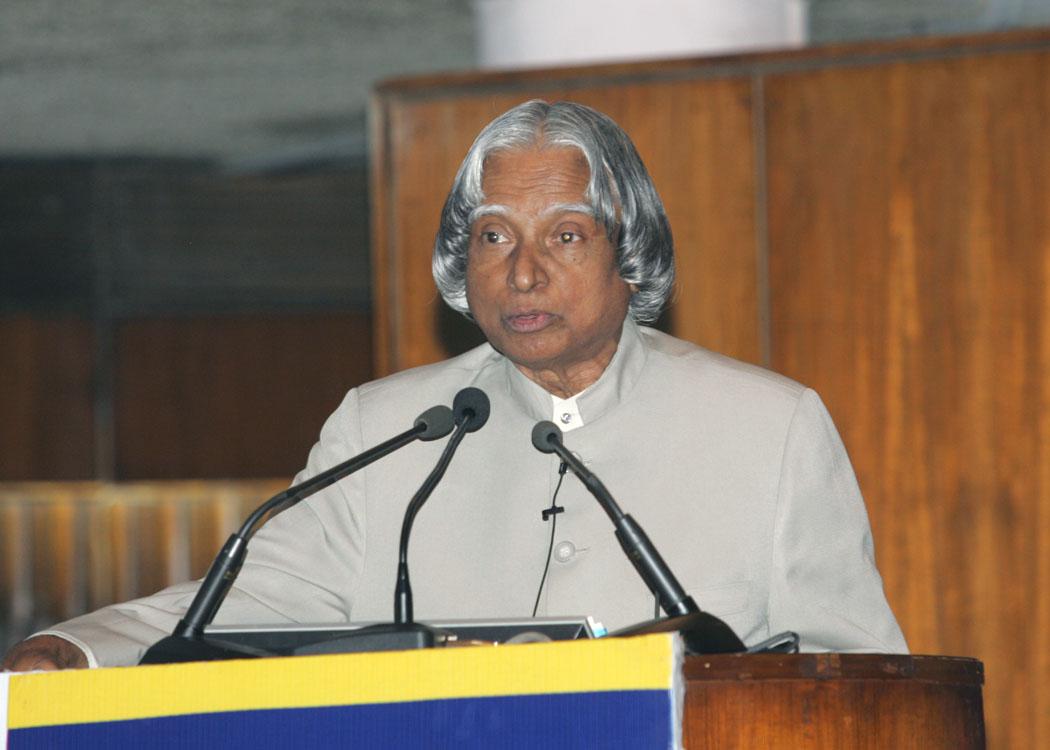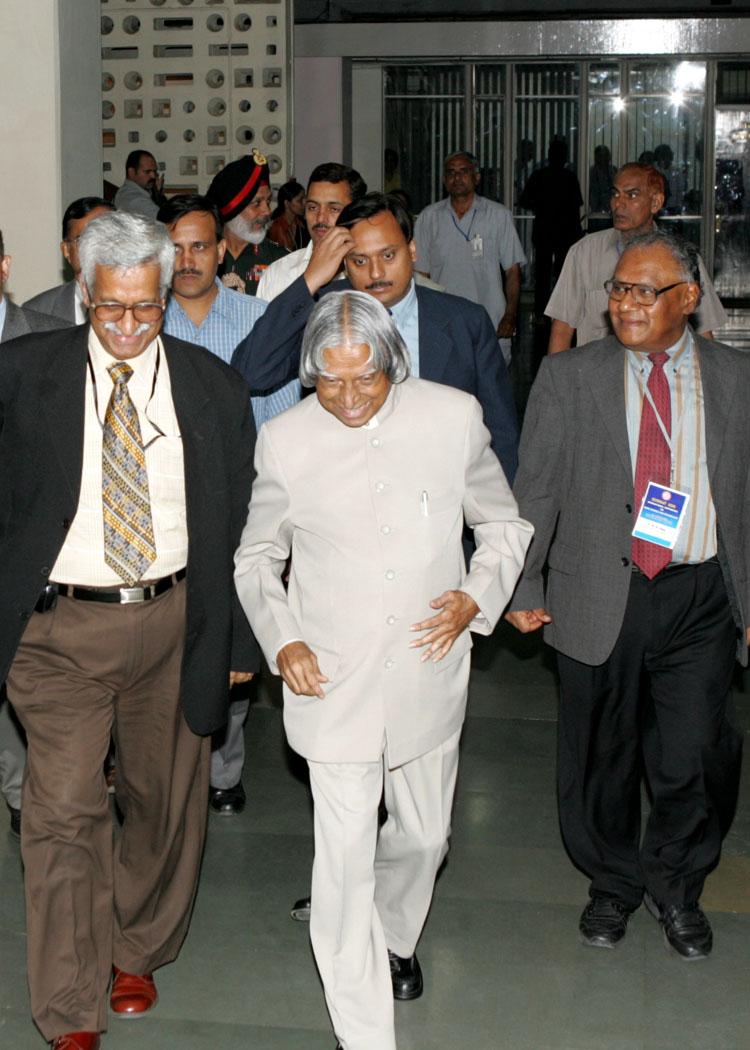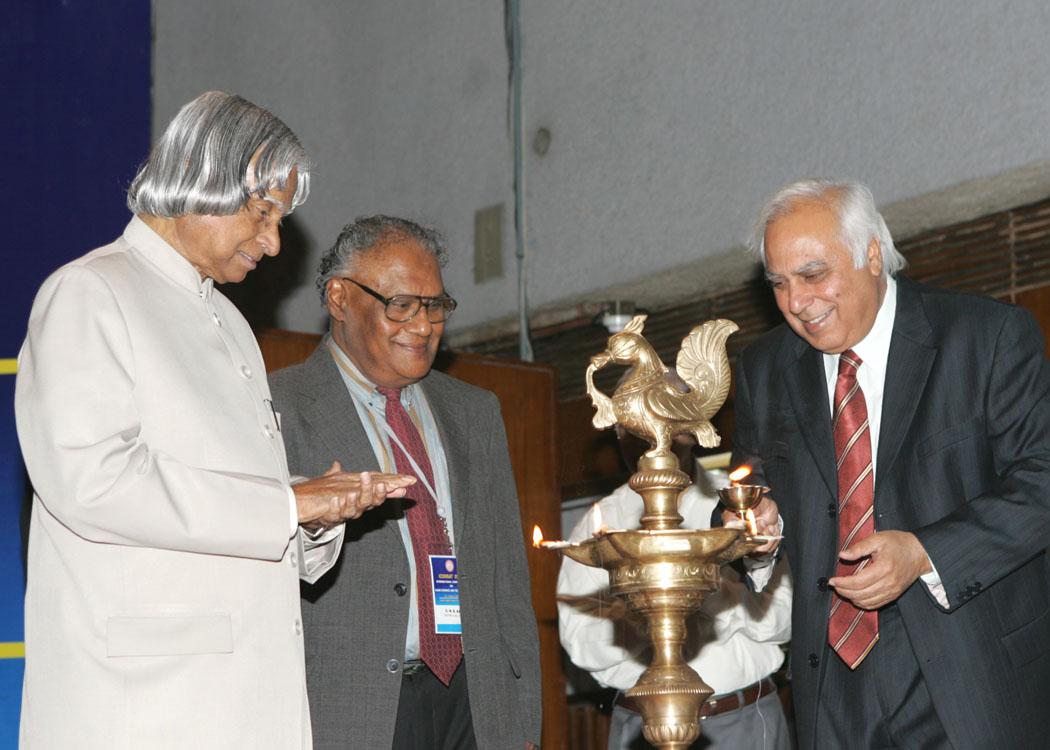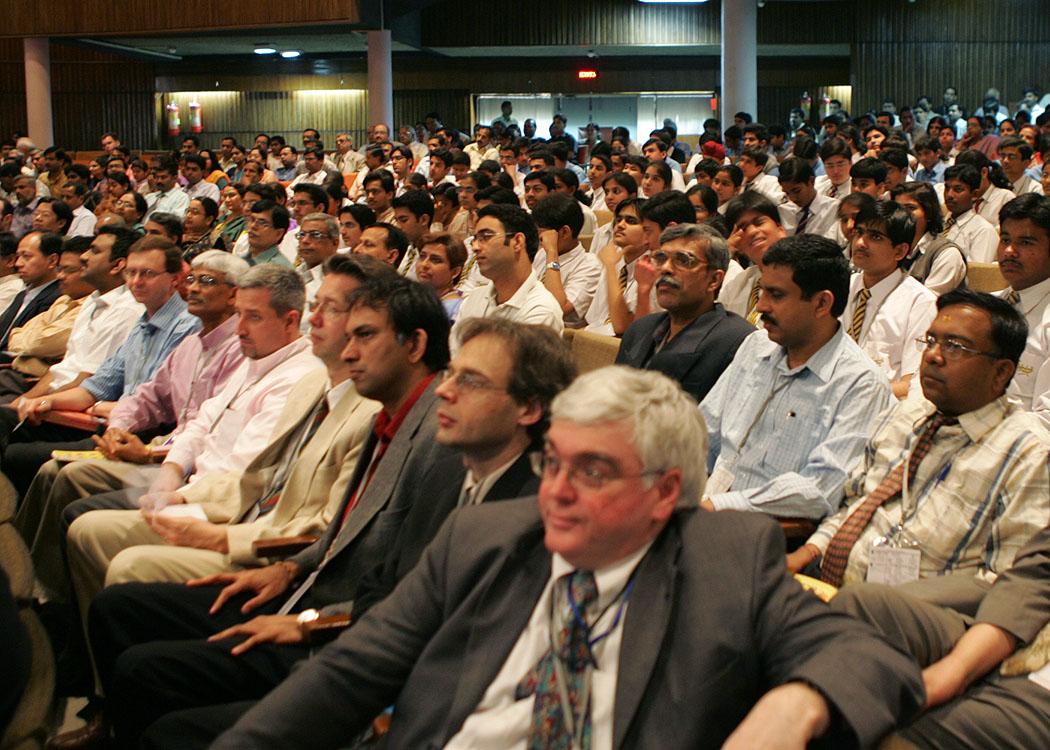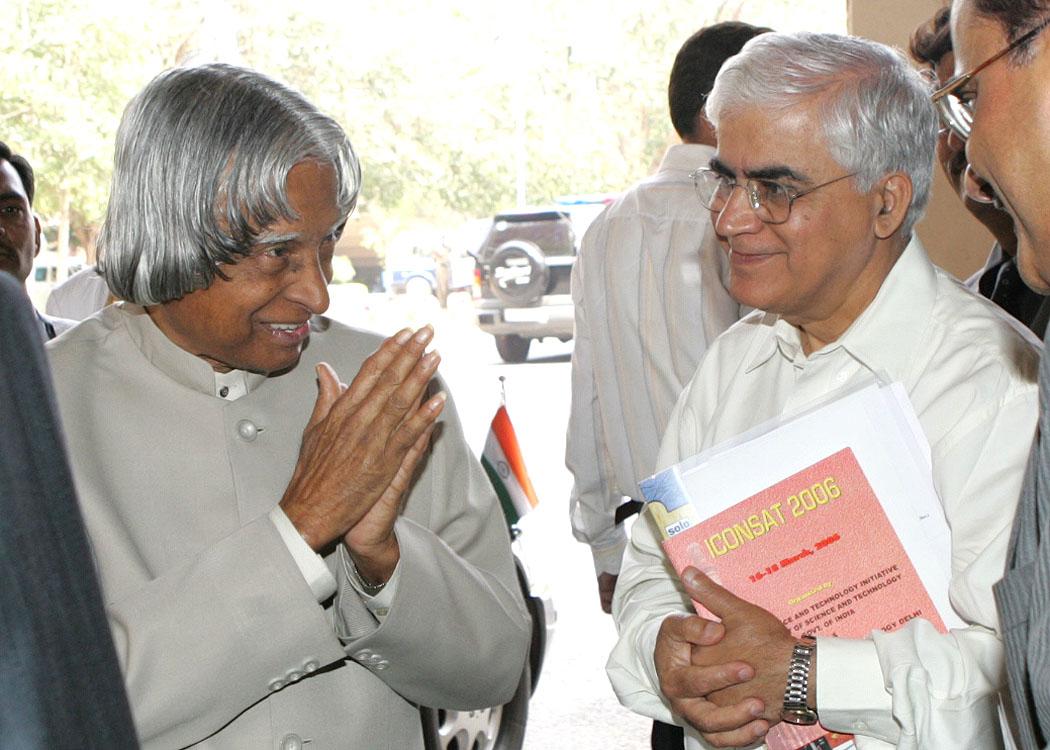Address At The Inauguration Of International Conference On Nano Science And Technology, New Delhi
New Delhi : 16-03-2006
Convergence of world nano research initiatives
"Small is Beautiful"
I am indeed delighted to participate in the inauguration of International Conference on Nano Science and Technology organized by the National Initiative of Nano Science and Technology of the Department of Science and Technology in partnership with IIT, Delhi. I greet the organizers, nano-scientists, researchers, technologists, academia, students and the distinguished invitees from India and abroad. I find that over three hundred and seventy five scientists and researchers are making poster presentation apart from the thirty six invited speakers on key technical areas which include synthesis routes, functionalities and properties in the nano scale and new applications and nano devices, computational nano science and nano biology. Some of the papers such as "Meeting Energy Demands - Nano Structure architecture for Solar Energy Conversion" by Prasanth V Kamath and ?Studying Nano Particles in Flight: The behaviour of free nano particles? F.E Kruis and others attracted my interest.
I liked the four poster presentations namely "The elastic properties of Nano tubes" by Roby Cherian and Priya Mahadevan, "Novel method of Fabrication and Characterization of Anthracene based nano structures by Alka Gupta and others, "Continuous Yarn from Polymeric Nano Fibers? by AK Mandal and other researchers, "Opto-Electronic properties of sol-gel synthesized tin oxide nano powder" by N. Sanakara Subramanian and other researchers with B. Santhi from Government Higher Secondary school. I will be happy to receive their full papers and poster presentation.
I would suggest that this conference can form a 5 member experienced nano task team to select 50 poster presentations that need to be highlighted for focused research and development leading to products. Over the last three years substantial amount of interest has arisen among the Indian scientists on nano science and technology. We are already in the growth path. One of the key advantages of nano science and technology is that there is hardly any time gap between the science being converted into technology. As soon as we detect a feasible solution in science, we can immediately convert it as a technology and lead to commercialization. There are many examples from India. We should make use of this advantage and come up with fast technological solutions for meeting the national requirements. The topic I have selected for this important audience for discussion "Convergence of world nano research initiatives".
I REVIEW ON NANO RESEARCH AND THOUGHTS
Recently, I was studying with my team the research results and other thoughts from various parts of the world. I find the research results and thoughts are unique and challenging compared to the conventional way of thinking. Let me discuss.
(a) Tiny Particles Target Prostate Cancer: University of Missouri, Columbia has opened a Nanoparticle Production Core Facility, which produces gold and silver nano particles used in medical research. The facility was established as a direct result of nanoscience discoveries made by Katti; Dr. Raghuraman Kannan, an assistant professor in radiology; and Kavita Katti, a research chemist in radiology. The team has developed methods for producing nanoparticles that are biocompatible and well-suited for nano medicine applications.
Using these results, scientists of University of Missouri (MU), Columbia are carrying out an important nanoparticle research which can improve the methods of detection and treatment for patients with prostate cancer, the second leading cause of cancer-related death among men. Scientist will create gold nano particles capable of imaging molecular abnormalities associated with the earliest stages of prostate cancer. Millions of the nano particles will be administered to target cancerous tumors in the prostate. Once the particles locate the early tumor, physicians will use an X-ray to see it. With this process, cancer may be detected in just one cell, possibly months or even years earlier than can be detected now. I have also discussed in Indo - US nano technology conclave about the research results of a similar detection kit for Typhoid by Prof. AK Sood, and his team from IISc in partnership with DRDE.
One of the important aspect of this research is MU uses interdisciplinary team of scientists - all on one campus ? with expertise in radiology, veterinary sciences, pathology, physics, chemistry, isotope production, engineering and biocompatible nanoparticle development. The national initiative on nano science and technology and the department of science and technology may like to take this aspect into account and encourage Indian institutions to come up with partners from multiple institutions with varying core competence and provide them a common platform and resources to enable them to work on inter-disciplinary research. This is one way of integrating scientists from multiple institutions working on nano science and technology spread across the country with sub optimal resources.
(b) Boosting Solar Cell Efficiency through Nano-technology: While inaugurating the Indo-US Nano technology Conclave in February 2006, I discussed with the nano science and technologists about the need for finding innovative solution for the use of nano-technology in solar energy applications using higher efficiency CNT based solar photovoltaic cells with an efficiency of over 45%. Pioneering research work has been done in Penn State University in this area. Recently, I have come across another work done by Researchers at Pennsylvania State University who have used arrays of titania nanotubes in place of titania nanoparticles in dye-sensitized solar cells. The resulting cells have shown promising photo conversion efficiencies.
"Our biggest challenge is simply finding a suitable means for titanium film deposition from which we make the nanotube arrays," said Grimes. I would recommend scientists assembled here to work independently or in partnership with the scientists of Pennslyvania State University to find a solution for this problem, which will have national and international significance towards energy independence of nations and protection of our environment.
"We have a very short negative electrode providing a remarkable photocurrent density ? the amplitude of which is generally proportional to the length up to the point all the light is absorbed," Craig Grimes of Pennsylvania State claims that if they could maintain such properties with increasing nanotube length, they should be able to achieve low cost solar cells of tremendous efficiencies ? basically up to the theoretical limit approximately 70%. I am very happy to see from the poster presentation of the conference that many laboratories in the country have started working in the CNT based Photo voltaic cells and other energy conversion systems. Now new challenges have come. Indian laboratories have to become partners in the development of both photo voltaic cells based on Carbon Nano Tubes and array of titania nanotubes. DST has to search and locate the nano science researchers from all parts of the country including colleges in the rural areas for partnering in this energy mission. The next area, which I would like to discuss, is on the Drug Delivery platform.
(c) Drug Delivery Platform: One of our institutions National Institute of Pharmaceutical Education and Research (NIPER) is in the process of creating oral drug delivery platform which will enable carrying out of research, development and technology transfer of drug delivery systems involving nanoparticles. To validate this platform, NIPER is considering the development of drug delivery systems for cancer treatment, estrogen delivery for the treatment of women and antioxidants. This research will lead to finding a cost effective solution to the efficacious use of the drug and also ensure pointed delivery of drug to the required site leading to prevention of toxic and side effects, which are associated with the conventional drug delivery systems. It is essential to create such platforms for many common applications not only in the drug delivery research but in many areas of nanoscience and technology research which will benefit multiple researchers coming from inter disciplinary areas.
d) National Nano Fabrication Centers: For fast research results from nano science and evolution of nano technology, certain unique equipments will be needed, they are:
1. Lithography (E-Beam, I-Line Stepper, Mask Aligner, Nano-Imprint, Microscope.
2. Etching (Oxide. Proly Etcher, Metal Etcher, PR Stripper, Deep Si Etcher)
3. Diffusion (LPCVD, RTP, Wet Station, Part Cleaner, Furnace)
4. Thin Film (Sputter, ALD, Ion Implanter, CMP)
5. Bio Chemical & New Materials ( Bond Aligner, Chip Aligner, laser Micro Machine, Fusion Bonder, Femto Second Laser, Nano Cluster Generator, Chemical Vapour Condensation, Nano Indentor XP)
6. Metrology (FE-TEM, FE-SEM, FIB, AFM)
Hence, it is essential to have multiple Nano Technology Fabrication Centers in different parts of the country equipped with above facilities. Establishment of these centers will enable considerable reduction in the time taken for translation of nano science to nano products. National Nano Fab Centre (NNFC) will provide service from concept to manufacturing engineering samples and to establish collaborations with satellite labs to optimize facility utilization among all the nano science and technology users in the country. Such a center can provide the research and foundry service including nano materials, nano-bio nano devices, NEMS and Fundamental Physics and Metrology. Probably this conference can discuss and recommend the creation of at least 4 National Nano Technology Fabrication Centers in different regions across the country. Here scientists, technologies and research students can work together, as presently we do not have the critical mass of trained human resource.
(e) Nano Particles: Propulsion Systems for Space Vehicles: Recently, I have come across some outstanding work, which has been carried out in some of the universities in India, in nano metal particles, which will provide high energy materials for different applications. One such development is for the space vehicles where the solid propellants can provide higher burn rates, several folds and at rocket motor level it can yield higher energy in terms of specific impulse. The research experience of Prof. (Mrs.) SV Boroskar at University of Pune has demonstrated Aluminium nano particles of 10-20 nm size using plasma torch and characterizing the particles in the nano aluminium propellants based on Di Octyl Ad-pates (DOA) to evolve a very high energy propellant for rocket motors. Prof. SR Chakravarti at IIT, Chennai has followed another route of Exploding Wire Technique to generate nano aluminium particles used with HTPB (Hydroxyl Terminated Poly Butadine) to enhance the burn rate by 80%. Nano aluminium will find many more applications in the future, most importantly, cost effective future space transportation including inter-planetary travel. It is essential that cost effective high energy transportation systems are developed to make space travel a viable proposition in the 21st century. The present research will definitely lead to path breaking results useful for space launch vehicle technology. I would request the researchers assembled here to find further innovative applications in nano particles research.
Now I would like to discuss a recent important discovery on the emission of green house gas by plants. Though it does not directly pertain to nano science and technology at present it has the potential to have far reaching implication in our understanding of the environmental problems facing the universe.
(f) Trees implicated in greenhouse gas conundrum: Frank Keppler at the Max Plank Institute for Nuclear Physics, Heidelberg, Germany, and his colleagues claim that plants emit upto 30% of the world?s methane every year. This has totally changed the discussions on the causes for climatic change. After discovering that fallen leaves, or plant litter, produced methane, Keppler investigated whether living plants also produce this highly reduced gas in air ? an oxygen rich environment. He calculated that plants give off between 60 and 240 million tonnes of methane per year. ?It is a new pathway of methane formation,? said Keppler, ?it will change our thinking about plants and their role in climate change.'
The news has shocked the atmospheric science community. ?I?m still amazed that people haven?t seen it before,? said David Lowe, from the National Institute of Water and Atmospheric Research, Wellington, New Zealand. ?You wouldn?t expect methane to come from plants and the air. You won?t find any chemical reaction that people know about that would do that.?
Ed D-lugo-ken-cky from the US National Oceanic and Atmospheric Administration expects most scientists to react with disbelief. ?Since plants produce hydrocarbons such as isoprene and terpenes in large amounts and single carbon compounds such as methyl halides and methanol, I should not be too surprised by this result,? he told Chemistry World. Both Lowe and Dlugokencky commented that Keppler?s experiments were so thorough there can be little room for doubt about the validity of Keppler?s claims.
Under Kyoto protocol rules, countries are allowed to use forest sinks to offset emissions. If a country emits lots of carbon dioxide, but plants new forests, it can subtract the carbon dioxide that the trees remove. In light of the news that plants produce large quantities of another greenhouse gas, politicians and scientists will now have to work out new strategies for calculating net carbon emissions from trees.
When I hear about this startling discovery I am reminded of the statement in 1895 by a well known scientist Lord Kelvin who was the President of Royal Society of London said, ?any thing heavier than air cannot fly, and cannot be flown.? Within a decade, Wright Brothers proved man could fly of course at heavy risk and cost. On the successful completion of Moon Mission in 1969, Von Braun, a very famous rocket designer, who built Saturn-V, to launch the capsule with astronauts and made moon walk a reality, in 1975 said ?If I am authorized, I will remove the word impossible?. These two incidents bring one important message for all scientists that we have to be always alert and responsive particularly for the nano scientists who are going to find rapid breakthrough in science technology leading to change in the thought process with new generations of inventions and discoveries, taking place in rapid succession.
II HUMAN RESOURCE DEVELOPMENT FOR NANO SCIENCE AND TECHNOLOGY RESEARCH
Presently, in my view, only around hundred scientists and researchers are working full time on nano science and technology research in the country. If the country has to maintain the research and development momentum which has picked up in the last two three years we need order of magnitude addition to this number at a fast pace. To overcome the situation while addressing the faculty and students of Indian Institute of Science, Bangalore on 19th February 2006, I have suggested planning and conduct of a special programme on convergence of technology (nano-bio-info) at the graduate, post-graduate and Ph.D level with continuous update. This is applicable to all the Universities and colleges which are having science and technology programme. In addition to the above for inspiring young mind, there is a need to introduce nano science and technology at the high school level also.
For example, I understand that National Science Foundation has entrusted the task of developing a curriculum to help high school students visualize the principles of nanoscience and nanotechnology. They claim that the nanoscopic world is awaiting discovery by high school students and educators, and seeing how the laws of physics behave in that world can shed light on how they behave in the real world. The curriculum has to include classroom-tested activities to help high school students understand the underlying principles, applications and implications of nano scale science. Some of the activities will be simple, one-day enrichment activities, and others will span several class periods. I would recommend some of the projects which have been displayed in the Conference can be selected to be part of the curriculum in all our high schools either through physical or virtual learning. In addition to the above, I would suggest the hundred scientists who are fully committed to nano science and technology at present should devote at least one week in a year to deliver popular lectures on nano science and technology to the high school students in a particular district. The conduct of this popular lecture series programme can be coordinated by the Department of Science and Technology in collaboration with the district authorities at a time convenient to the students and also the researchers.
Conclusion
Nano science, Nano technology and Nano Fabrication have a large interconnectivity and together have potential for fast realization of products from nano science, unlike what the scientific history so far taught us. Also nano science and technologies are multi-disciplinary. Hence the nano science, nano technology and nano fabrication teams have to work in an integrated way in a mission mode operation. A new way of thinking in our nation is essential. Any thing needed in that direction, I will certainly assist. To summarize, the following are the suggestions for the nano science and technology community, which can use this ICONSAT 2006 forum and lead to an integrated solution.
1. There should be a dynamic research search task team with renowned scientists, who will visit not only certain institutions, but also the colleges located at various parts of the country to locate research potential of individual and the institutions.
2. Evolution of National drug delivery platform, which will bring together the potential researchers, technologists and industries.
3. Establishment of 4 fully equipped regional National Nano Fab Centers across the country.
4. Focus to be provided for National Nano Research areas for time bound results:
i. High efficiency Solar Photovoltaic Cells (Min 50% efficiency )
ii. Cancer, HIV/AIDS diagnosis and treatment (DNA ? Nano Robots)
iii. Nano materials, Nano structures, Nano devices and Nano electronics
iv. Nano sensors for multiple applications.
v. Nano filters for low cost water purification and providing safe drinking water.
5. Students from five countries can be enlisted by Indian laboratories for research in nano science leading to the award of Ph.D.
Friends, when I see you all from different parts of the planet. I would like to say that you are blessed with a rare scientific opportunity which can be used for transforming the research results into products in a very short time. For enabling this opportunity to be captured, nations have to work together on selected missions, which will enrich various societies in the world.
I am very happy to inaugurate ICONSAT 2006. My best wishes to all the participants of the International Conference for success in their mission of discovering new avenues of using nano science and technology for societal transformation.
May God bless you.

